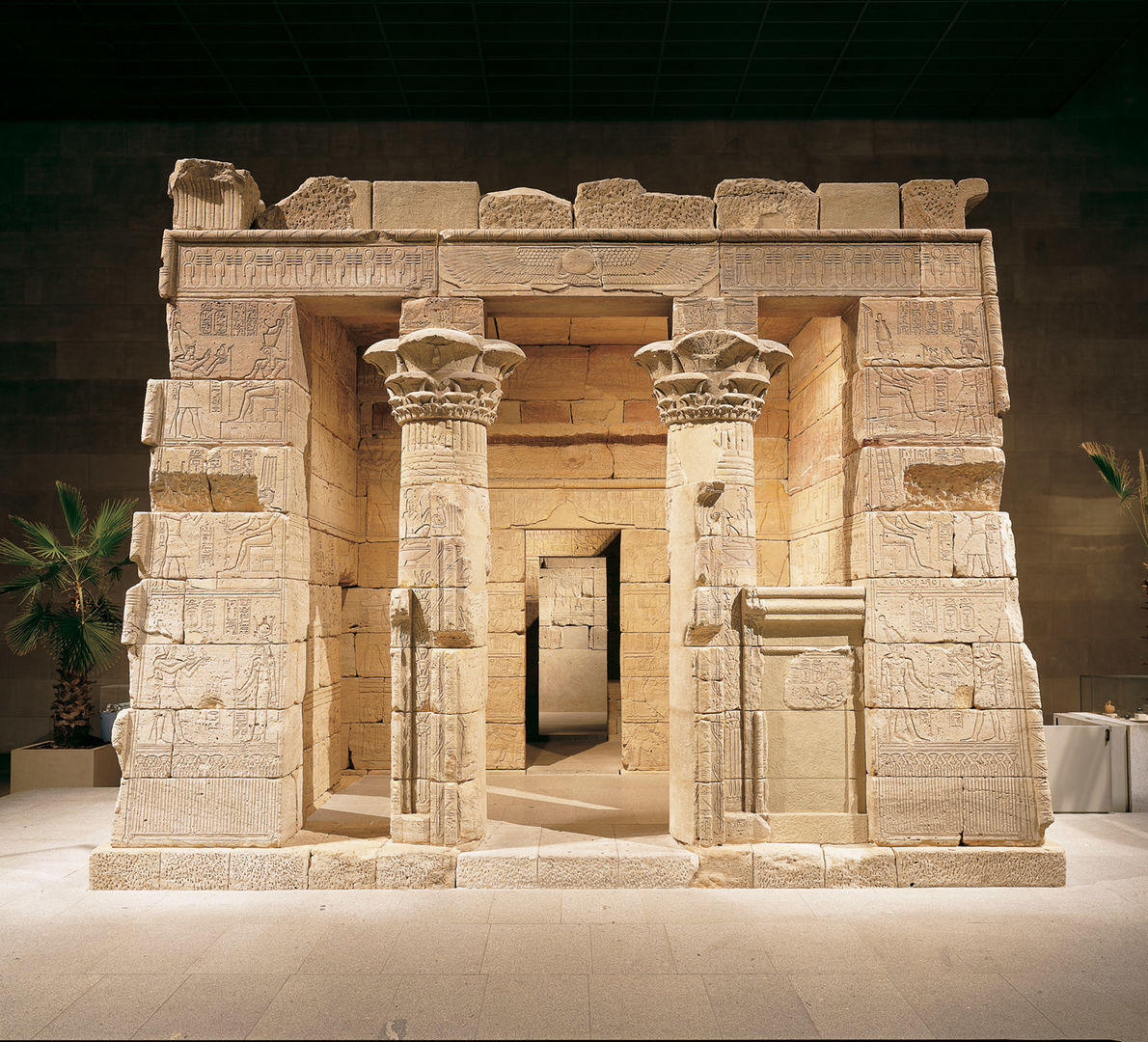Architecture and the Natural World

The Temple of Dendur, Roman Period, reign of Augustus Caesar, ca. 15 B.C. Egypt, Nubia, Dendur, west bank of the Nile River, 50 miles south of Aswan. Aeolian Sandstone, L. from gate to rear of temple 24 m 60 cm (82 ft.). Given to the United States by Egypt in 1965, awarded to The Metropolitan Museum of Art in 1967 (68.154)
Collection Area: Egyptian Art
Subject Areas: English Language Arts, Geography, Visual Arts, World History
Grades: Middle School
Topic/Theme: Art as a Primary Resource
Goals
Students will be able to:
- generate evidence-based inferences about the relationship between humans and the natural world in Nubia around 15 B.C.;
- identify ways the decoration and form of the Temple of Dendur reflect the natural world; and
- compare and contrast the influence of the natural world in works of art from different locations and time periods.
National Learning Standards
English Language Arts
NL-ENG.K-12.4 Communication Skills
NL-ENG.K-12.12 Applying Language Skills
Visual Arts
NA-VA.K-8.4 Understanding the Visual Arts in Relation to History and Cultures
NA-VA.K-8.6 Making Connections between Visual Arts and Other Disciplines
World History
NSS-WH.5-12.3 Era 3: Classical Traditions, Major Religions, and Giant Empires 1000 bce–300 ce
Common Core State Standards
English Language Arts
CCSS.ELA-Literacy.CCRA.R.2 Determine central ideas or themes of a text and analyze their development; summarize the key supporting details and ideas.*
CCSS.ELA-Literacy.CCRA.R.7 Integrate and evaluate content presented in diverse media and formats, including visually and quantitatively, as well as in words.
CCSS.ELA-Literacy.CCRA.W.2 Write informative/explanatory texts to examine and convey complex ideas and information clearly and accurately through the effective selection, organization, and analysis of content.
*Art as text
Questions for Viewing
- Take a moment to look closely at this ancient building. How would you describe it to someone who has never seen it? What do you see that makes you say that?
- This Egyptian temple once rested on the bank of the Nile River. The government of Egypt gave it to the United States when it dismantled the temple to save it from flooding. The temple not only honored the goddess Isis and two local men, but also symbolized the natural world as the ancient Egyptians knew it. Look closely at the way it is decorated.
- What details might have been inspired by nature? [Note: The organization of natural imagery mirrors a landscape, with plants growing from the earth at the bottom to winged birds flying high above.]
- What might this temple suggest about the relationship between the ancient Egyptians and their environment? What evidence supports your ideas?
- Think about the buildings in your community. What might they suggest about your community's outlook on the natural world?
Activity
Activity Setting: Museum
Materials: Drawing paper, pencils
Subject Areas: English Language Arts, Geography, Visual Arts, World History
Duration: 30 minutes
Fold a sheet of paper in half vertically. On one half, sketch a pillar from The Temple of Dendur, and on the other half sketch a pillar from the loggia (an area on the side of a building that has a roof and that is open on one side) designed in 1905 by American artist Louis Comfort Tiffany as a private entrance to his home. Look closely at your sketches. How does each work of art reflect the natural world? What sets the two pillars apart? Write a short wall label (as you might find in a Museum gallery) for the loggia, highlighting its unique qualities and visual ties to ancient Egypt. [Hint: Use visual details in your drawings to enhance your text as well as information gleaned from the essay "Egyptian Revival," explaining ways major Egyptian art motifs gained popularity in American art during the early 1800s.]
Resources
Ickow, Sara. "Egyptian Revival." In Heilbrunn Timeline of Art History. New York: The Metropolitan Museum of Art, 2000–. (July 2012)
"Temple of Dendur, The [Egyptian; Dendur, Nubia]" (68.154). In Heilbrunn Timeline of Art History. New York: The Metropolitan Museum of Art, 2000–. (October 2006)
Watts, Edith. The Art of Ancient Egypt: A Resource for Educators. New York: The Metropolitan Museum of Art, 1998. Download the resource (PDF).
Objects in the Museum's Collection Related to this Lesson
Louis Comfort Tiffany (American, 1848–1933), Loggia from Laurelton Hall, Oyster Bay, New York, ca. 1905. Limestone, ceramic, and Favrile glass, 640.1 x 701 cm (21 x 23 ft.). The Metropolitan Museum of Art, New York, Gift of Jeannette Genius McKean and Hugh Ferguson McKean, in memory of Charles Hosmer Morse, 1978 (1978.10.1)
Félix Bonfils (French, 1831–1885), Temple d'Andour, ca. 1870. Albumen silver print from glass negative, 17.3 x 23.0 cm (6 13/16 x 9 1/16 in.). The Metropolitan Museum of Art, New York, Gift of Daniel Wolf, in memory of Diane R. Wolf, 1976 (1976.561.1)
Mastaba Tomb of Perneb, Old Kingdom, Dynasty 5, end, reign of Isesi–Unis, ca. 2381–2323 B.C. Egypt, Memphite Region, Saqqara, Tomb of Perneb, Quibell, Egyptian Antiquities Service. Limestone, paint, H. 482.2 cm (15 ft. 9 13/16 in.). The Metropolitan Museum of Art, New York, Gift of Edward S. Harkness, 1913 (13.183.3)
Author: Monique Stanton; affiliation: PS 102, The Bay View School, 2014